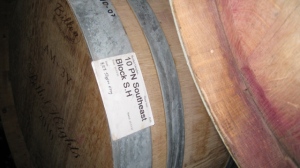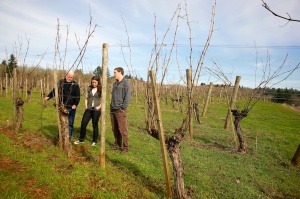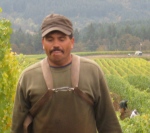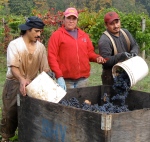
 When we planted it in 1979, the Southeast Block looked just like the other two Pinot blocks planted that year on the newly cleared east side of our vineyard, with cuttings from Dick Erath’s Pommard clone Pinot noir stuck directly into the ground without benefit of phylloxera-resistant rootstock.
When we planted it in 1979, the Southeast Block looked just like the other two Pinot blocks planted that year on the newly cleared east side of our vineyard, with cuttings from Dick Erath’s Pommard clone Pinot noir stuck directly into the ground without benefit of phylloxera-resistant rootstock.
But soon after these three look-alike Pinot blocks started producing fruit, differences in their soil depth began to assert themselves. The South Block was always a bit overly vigorous; the Flat Block was always a bit weak. The Southeast Block was always Just Right, and was clearly destined to be Goldilocks’ favorite.
To top it off, in 1998 the famous French geologist Yves Herody, consultant to many of Burgundy’s biodynamic vignerons, declared that our Southeast Block was created by a different geological event than the blocks next to it, giving its parent rock a Unique Mineral Content. By then it had already become our glory hog.

 During the ‘80’s, when we were still selling most of our fruit to other wineries, the Southeast Block was the Chosen Block of Domaine Drouhin Oregon. After 1991, when we started bottling our own Southeast Block designated wine, it regularly got the highest score of all our Pinots. It was almost always our Featured Wine at the International Pinot Noir Celebration. It usually provided our Chosen Barrel for the ¡Salud! auction.
During the ‘80’s, when we were still selling most of our fruit to other wineries, the Southeast Block was the Chosen Block of Domaine Drouhin Oregon. After 1991, when we started bottling our own Southeast Block designated wine, it regularly got the highest score of all our Pinots. It was almost always our Featured Wine at the International Pinot Noir Celebration. It usually provided our Chosen Barrel for the ¡Salud! auction.
Always a prima donna, unwilling to share the spotlight, the SEB has never been a component in our Casteel Reserve.
In 2006 the Southeast Block was the Chosen Block for the Cellar Crawl Collection, a “best block” fruit trade experiment between Bethel Heights, Penner-Ash, Ken Wright, Cristom and Solena.
This year the 2008 Southeast Block was selected as the only Oregon Pinot for the inspiring wine list at Boston’s new Legal Harborside Restaurant, a collection of only 50 wines from around the world “whose personality originates from an individual place, wine whose identity reflects a single family’s connection to the particular parcel of earth that it tends.”
As Ben described it for the Harborside Collection, “The roots of these own-rooted vines have grown down and explored our rocky volcanic soil for over thirty years, and in doing so have produced wines that are defined far more by their place, than by vintage or by the hand of the winemaker. Since my father first started bottling wines from the Southeast Block as single-block designates in 1991, this block has given us wines with a firm backbone combined with robust savory fruit and a deep minerality that is unique to this place.”
The Southeast Block is thirty-two years old this year. There are signs that phylloxera has finally discovered its unprotected roots, but Mimi’s worm tea is being liberally applied to boost its immune system, and we believe its best years may still be ahead. Certainly the 2007 and 2008 Southeast Block Pinots are two of the most glorious and ageworthy wines we have ever produced.
 If the Southeast Block were a person, who would it be?
If the Southeast Block were a person, who would it be?
Ted: Spencer Tracy or Humphrey Bogart (a bit rough on the outside, but solid intellect and sweet heart on the inside)
Mimi: Robert Redford (good when young, great when old)
Ben: Paul Newman (better than Redford, same reasons)
Kate: Katherine Hepburn
Mimi: SEB can’t be a woman, but if it were, it would be Katherine Hepburn
Pat: Sean Connery (tough but smooth, becoming more interesting with age)
Mimi: Not Sean Connery. SEB can’t have an accent.
Terry: Jamie Tombaugh (because if the SEB has anything, it has character)



























 Bethel Heights 2007 Pinot Noir Estate Grown (aka the Black Label Pinot) is finally released! The 2006 Estate Pinot was sold out months ago, but we held back the release of the 2007 until now, instead of releasing in November as we did in 2006.
Bethel Heights 2007 Pinot Noir Estate Grown (aka the Black Label Pinot) is finally released! The 2006 Estate Pinot was sold out months ago, but we held back the release of the 2007 until now, instead of releasing in November as we did in 2006.